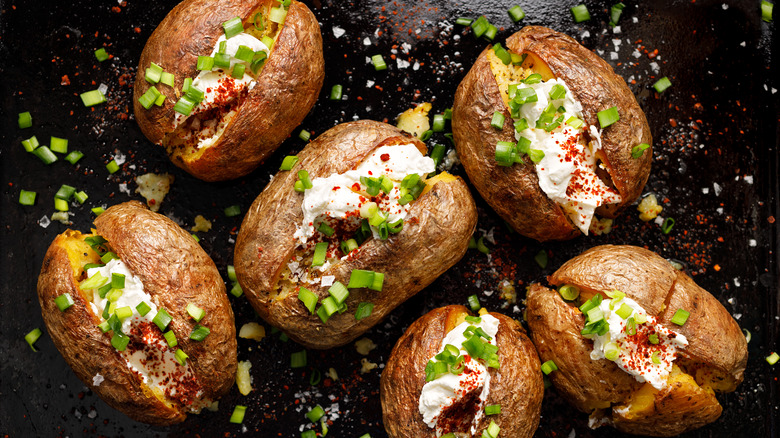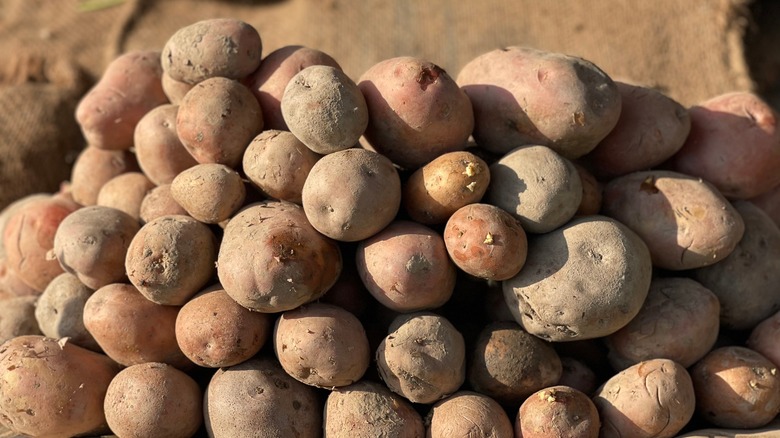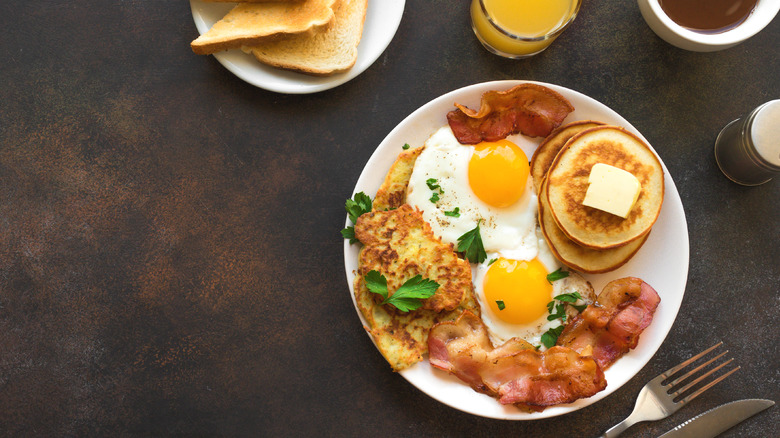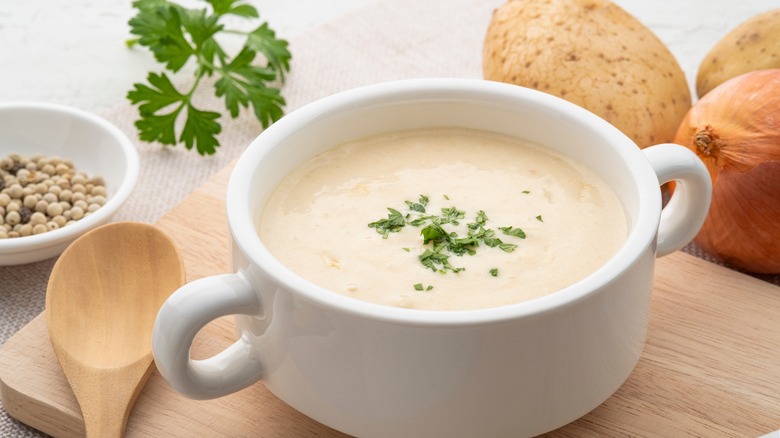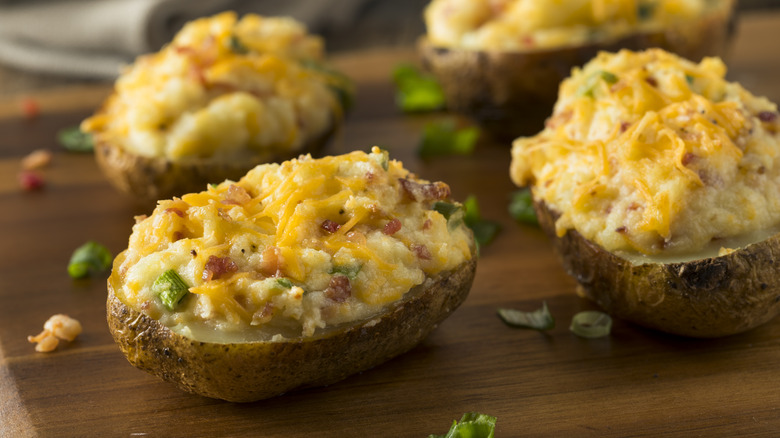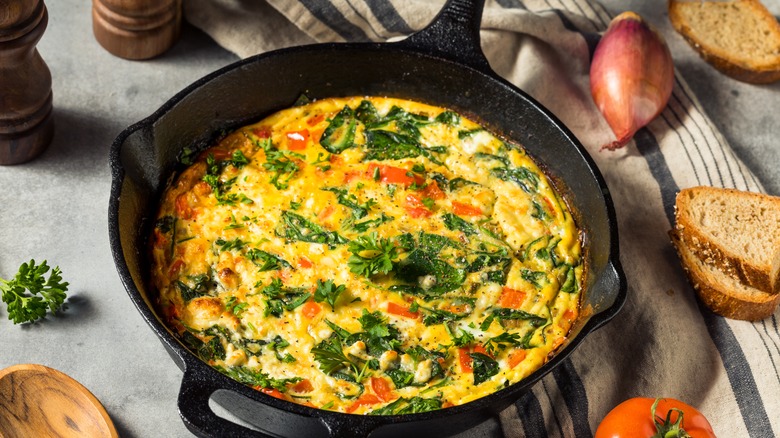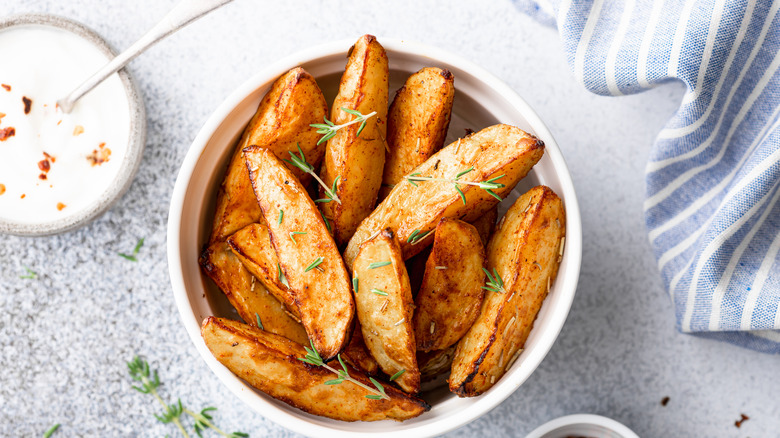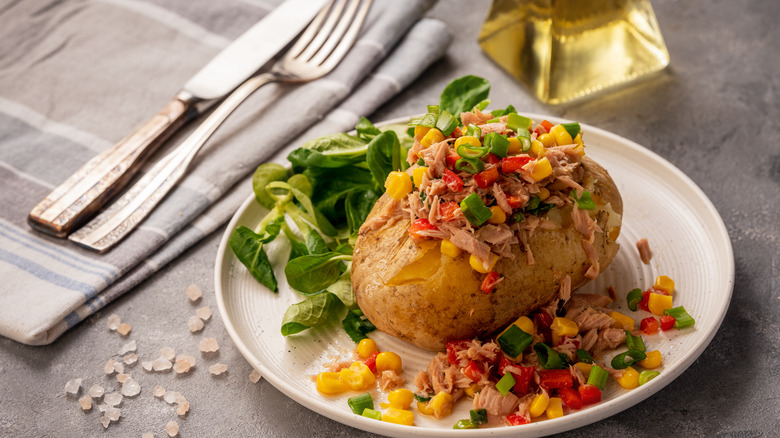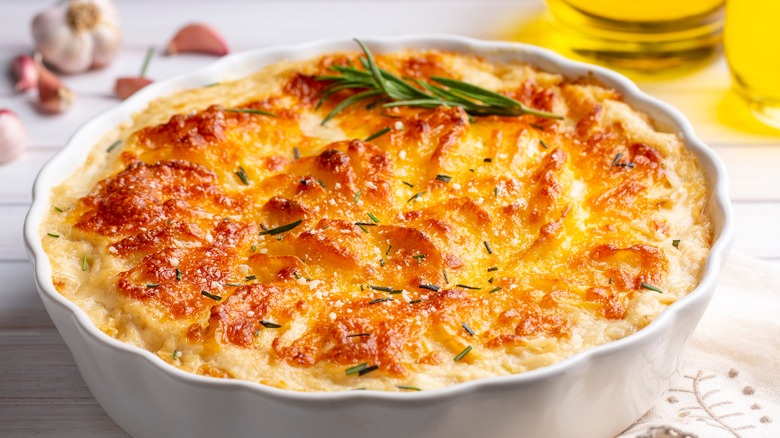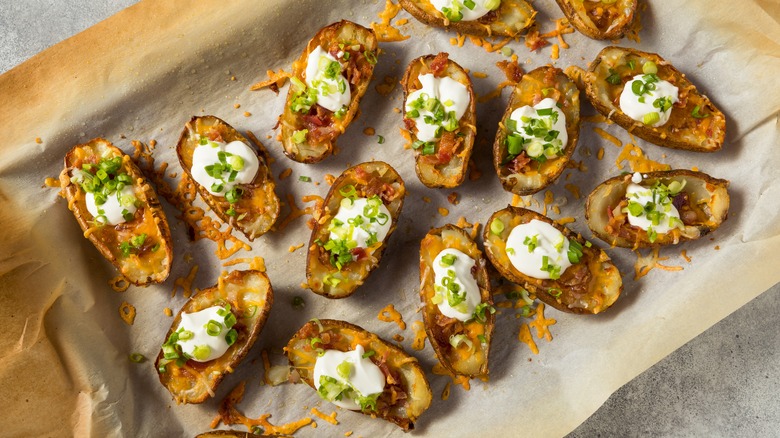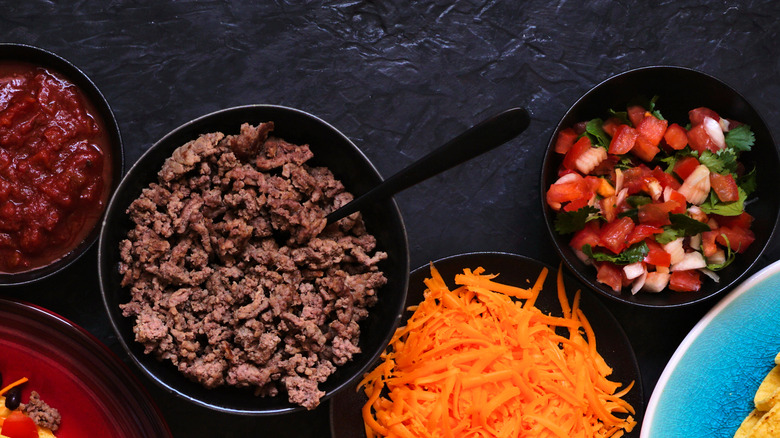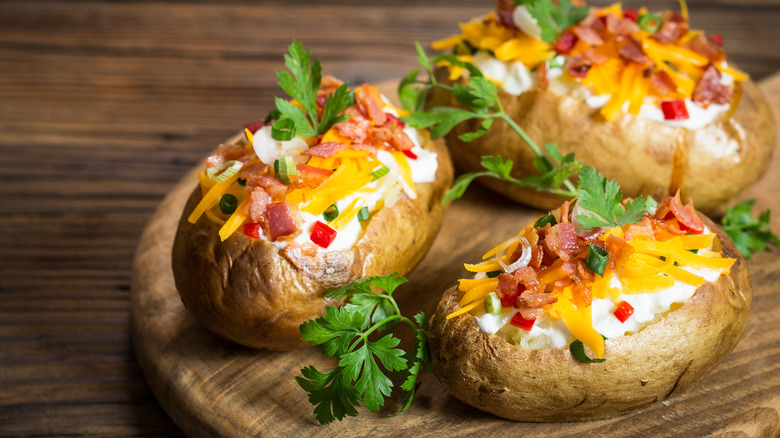What To Do With Leftover Baked Potatoes
Americans love potatoes, and that is a fact. The average American consumes 117 pounds of potatoes each year (per the Idaho Potato Commission). Most of the potatoes we eat come home frozen (French fries and tater tots, anyone?), followed by fresh potatoes and potato chips.
But potatoes are not popular in just in the United States. According to the International Potato Center, potatoes are the third most important crop worldwide, a staple ingredient in many cultures. That should come as no surprise because potatoes are not only delicious, but they are also incredibly versatile. You can boil, bake, fry, roast, and mash potatoes. Plus, you can eat them with any meal, from eggs and home fries for breakfast to meat and potatoes for dinner. Even the pickiest of eaters likes potatoes, making them a favorite with parents around the globe. You could serve potatoes every day without running out of new variations.
Potatoes are nutritious and affordable
Not only are potatoes delicious but they are packed with nutrition. A single serving of cooked potatoes (about 2/3 of a cup) is a good source of vitamin C, potassium, folate, and vitamin B6 (per Healthline). They provide a moderate amount of protein and fiber. By themselves, potatoes are low-fat and low-calorie, with just 87 calories and 0.1 grams of fat. Of course, loading them up with cheese and sour cream changes the nutritional profile.
With grocery prices rapidly rising, people are all looking for a bargain. Potatoes are relatively cheap, typically priced around $1 to $2 per pound with even lower sale prices. It is easy to stretch a 5-pound bag of potatoes to make multiple meals. Of course, nothing is budget-friendly if it goes to waste. Potatoes, like all produce, will go bad over time. Plan your meals around the potatoes and other ingredients you already have, be sure to store them properly in a cool, dry location, and of course, never throw out leftover potatoes. That's just like throwing money in the trash.
If you bake potatoes for dinner, you might as well bake several. After all, the oven is already hot, and throwing a few more in there does not create extra work. If you end up with leftover baked potatoes, don't worry. There are plenty of ways to use them up.
Serve potatoes for breakfast
If you have uneaten baked potatoes when dinner is over, why not serve them for breakfast the next day? While baked potatoes are not a traditional breakfast food, many other potato variations are. Instead of eggs and toast, serve eggs with hash browns or home fries using your leftover baked potatoes.
This recipe for Traditional Hash Browns will not disappoint. Dice an onion alongside your baked potatoes, then toss the potatoes with chili powder, salt, and pepper. Since the potatoes have already been baked, you will probably need to spray them with cooking spray or toss them with oil to ensure the spices stick. Bake the potatoes for 25 minutes at 425 degrees Fahrenheit while you sauté the onion over medium heat, then serve together.
Home fries are another great way to use up your leftover baked potatoes. Many recipes for home fries call for parboiling the potatoes before frying them. The point of this step is to pre-cook the potatoes so that you do not need to rely on frying to cook them all the way through. When you start with leftover potatoes, you can skip parboiling because they have already been baked. Simply cut them into wedges or cubes, then toss with oil, salt, and pepper. Fry them in a skillet or frying pan or fire up the grill, and try this recipe for Grilled Steak, Eggs, and Homefries.
Make potato soup
Potato soup is the ultimate comfort food. Nothing says curl up on the couch with a cozy blanket like a giant mug of piping hot, carb-rich potato soup. It's easy to make, hard to mess up, and there are a thousand variations. While many recipes start with raw potatoes, you can easily use leftover baked potatoes to make potato soup.
If you have a favorite potato soup recipe, simply follow it, and use your leftover baked potatoes whenever it calls for potatoes. If not, here is a basic version of potato soup: Start by sauteing onions, carrots, and celery in olive oil in a Dutch oven or stockpot. While these aromatics cook, dice your leftover baked potatoes. Add them to the pot, then cover with water or broth. Increase the heat to high until the soup reaches a rolling boil, then simmer. Remove from heat and serve, adding milk if you like for a rich flavor. Be sure to add milk after removing the soup from the heat or you may scald the milk.
You can make potato soup vegan, vegetarian, low-cal, low-fat, or completely decadent (hint: Try this Loaded Potato Soup). For vegan or vegetarian potato soup, use vegetable broth and soy, almond, or another milk alternative. You can increase the nutritional profile by throwing in frozen spinach, kale, or broccoli. To make it heartier, add canned beans or diced, pre-cooked ham when you add the potatoes. You can top potato soup with shredded cheese, bacon, or ground beef.
Make twice-baked potatoes
Leftover baked potatoes practically beg you to make twice-baked potatoes. After all, you've already baked them once. If you have never had them before, twice-baked potatoes are basically baked potatoes on steroids. You scoop out the baked potato, leaving the skin intact, then mix the potato with butter, milk, and sour cream. Then, you stuff the potato again, top with cheese, and bake it again (hence the name).
For a classic version, try this recipe for Twice-Baked Potatoes. If you refrigerated the potatoes overnight, you will need to extend the baking time to make sure they are fully warmed through. While this recipe calls for bacon, you can omit the meat without losing any flavor.
Twice-baked potatoes are versatile, which makes them great for using up leftovers. In fact, you can browse your refrigerator to see what other leftovers you can use up at the same time. Got a half-stick of cream cheese lying around? Use it instead of sour cream. Have some leftover broccoli or frozen spinach? Throw it in there to boost the nutrition. (Hint: This is a great way to get picky eaters to consume some extra veggies.)
While traditional twice-baked potatoes are dairy-heavy, you can easily make them vegan. Simply substitute vegan butter for the butter, silken tofu for sour cream, and your favorite milk alternative for the milk. Top with vegan cheese if you like. Not everyone likes the way vegan cheese melts, so you can omit it without losing any flavor.
Try a frittata
People often serve a frittata for brunch, but this egg dish works well at any time of day. Frittata means "fried" in Italian, and you will start by frying the egg mixture on the stovetop, though you will finish by baking it in the oven. Sort of like a quiche without the crust, a frittata is tasty, easy to make, and a great way to use up leftover baked potatoes as well as any other odds and ends you find in the fridge.
While there are countless variations of the frittata, this classic frittata recipe is a great place to start. Prep your baked potatoes by dicing them, then go ahead and dice anything else you want to throw in: bell peppers, onions, ham, precooked bacon, cheddar — the combinations are endless. You may want to sauté certain vegetables, such as onions and broccoli, beforehand, but it's up to you. Then beat the eggs, potatoes, and other ingredients together.
Heat on the stovetop in an ovenproof skillet (cast iron works well) until the eggs are set, then transfer to an oven preheated to 325 degrees Fahrenheit. Bake until the frittata is completely set.
One nice thing about a frittata is that you can eat it fresh out of the oven or cook it in advance and eat it later. It tastes great cold or at room temperature. For breakfast, serve with fruit and toast. For lunch or dinner, add a loaf of crusty bread and a hearty salad.
Try a side of potato wedges
When you think of potatoes on the side, you might think first of French fries — which are, of course, delicious. But potato wedges are another tasty way to serve potatoes on the side, and they are easier to make and create less of a mess. It's a win-win!
To make roasted potato wedges from leftover baked potatoes, preheat the oven to 425 degrees Fahrenheit as you slice the potatoes into wedges. An easy way to do this is to slice the potato in half lengthwise, then slice each piece in half again lengthwise to create four equal wedges. If your potato is very large, you may want to slice your wedges once more. Do this to all your potatoes, trying to create wedges of equal thickness so that they cook evenly.
Once your wedges are ready, spritz them with olive oil spray or toss with olive oil. The potatoes will be dry from being baked, so you need to coat them in oil to ensure that the spices stick. Next, season to taste with salt and pepper, as well as garlic powder, onion powder, or paprika. Spread in an even, single layer on a baking sheet, then roast for roughly 20 minutes. The wedges will look crisp and lightly browned when done.
Build-your-own baked potato bar
One great way to use up leftover baked potatoes is to make a build-your-own baked potato bar. This spin on potatoes takes them from a side dish to a main course. It's also a lot of fun for the kids (and the adults) in your house.
To prep your DIY potato bar, start by reheating your leftover baked potatoes. If you only have a few, pop them in the microwave, but if you have several it is probably faster to heat them in the oven. While the potatoes are warming up, put together an assembly line of hearty toppings. Start with proteins like beans, chili, ground beef, canned tuna, or canned salmon. Then, line up some precooked vegetables like broccoli, spinach, and corn. Top with sour cream, shredded cheese, chives, and crumbled bacon.
A potato bar is an easy way to let everyone in your family put their own spin on a loaded baked potato. They can go with a Mexican twist by using chili, cheese, corn, and salsa, take a seafood spin with tuna and cheese, or keep it simple with sour cream, salt, and pepper. It is also the perfect way to clear out all the odds and ends sitting in your refrigerator in little plastic containers.
Potato casserole with a twist
Potato casserole is a favorite winter dish, and it is the perfect way to use up leftover baked potatoes. Potato casserole is essentially mashed potatoes jacked up with milk, cream cheese, sour cream, cheddar, and bacon, then baked to create a crispy top layer with a gooey inside. To use leftover baked potatoes instead of mashed potatoes, simply scoop out the soft, cooked potato and mash it, reserving the skins for another use (like baked potato skins). Then proceed with your family recipe, or try this Potato Casserole.
One great thing about potato casserole is that it is a flexible dish. Out of sour cream? Just add extra milk or substitute plain yogurt. Leave out the bacon to make it vegetarian or make it vegan by substituting vegan milk, vegan sour cream, vegan cream cheese, and vegan cheese for the dairy products. You can also use silken tofu in place of sour cream and cream cheese. Vary the proportions based on what you have and what you like, and it should still come out fantastic.
Make baked potato skins
If you use the cooked potato from your leftover baked potatoes in a recipe like potato casserole or potato soup, you will be left with scooped-out potato skins just begging you to make Homemade Baked Potato Skins like these from Spend With Pennies. Baked potato skins are a great appetizer to bring with you to a party or to eat while you watch football from the comfort of your own couch.
To make potato skins, brush the empty skins on the inside and outside with butter seasoned with salt, pepper, parsley, and garlic powder. Place them upside down in a baking dish and bake for 15 minutes at 425 degrees Fahrenheit. Flip the skins over, then bake for another five minutes or until they are crispy. Remove from the oven, fill them with cheddar cheese and bacon, then bake for another five minutes or until the cheese is bubbly. Top with sour cream and chives, and they are ready to enjoy You can change up this recipe by altering the meat and cheese combinations. Try Swiss cheese and shredded chicken, gouda and pepperoni, or even mini-meatballs and mozzarella. You can also leave out the meat entirely for a vegetarian version.
Try potato nachos
Nachos are the perfect game day side dish, and with hearty toppings, nachos can easily double as a meal. While traditional nachos use corn tortilla chips, you can make potato nachos using your leftover baked potatoes. They taste just as good, and since they do not rely on deep-fried tortilla chips, you can even think of them as a healthy choice.
To make potato nachos, slice your cold baked potatoes into thin slices to use as chips. Spread them in an even layer on a baking sheet, then roast in an oven that has been preheated to 425 degrees Fahrenheit. Roast for five minutes, flip with a spatula, then roast for five more minutes. Ten minutes should be enough to thoroughly heat the slices, but if not, pop them back in for a few minutes.
Once the slices are roasted to your liking, remove the baking sheet from the oven. Use a spatula to create layers of potato slices that are strong enough to hold your toppings. Then, top with your favorite nacho add-ons. Ground beef, shredded chicken, and canned chili are all popular proteins for nachos. Top them with shredded Monterey Jack cheese and sliced jalapenos. Return the baking sheet to the oven until the cheese is fully melted, then remove and add salsa, sour cream, and chopped red onion.
Serve leftover baked potatoes
While there are a million ways to use leftover baked potatoes in a recipe, the obvious choice is right in front of you: Simply serve baked potatoes again! There's nothing wrong with having the same thing two nights in a row or twice in one week. Store baked potatoes in the refrigerator for no more than a few days before serving again. You can reheat them in the microwave or the oven, then serve alongside any meat and hot vegetable for your classic meat and potatoes dinner, or as a standalone dish for lunch.
If you want to keep your baked potatoes for another day but do not want to serve them again right away, you can freeze baked potatoes. Let them cool completely, then wrap them tightly in plastic wrap to prevent freezer burn. Store them in your freezer, where they will keep for a few months. When you are ready to serve them again, let them thaw to room temperature before reheating.
